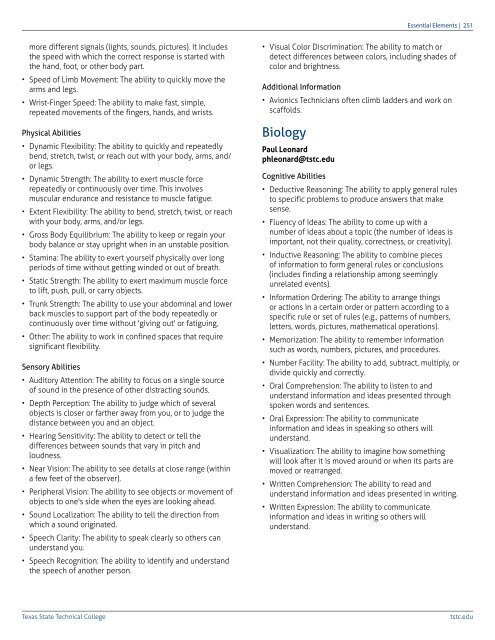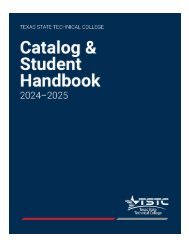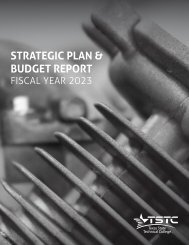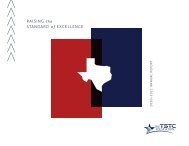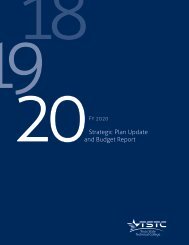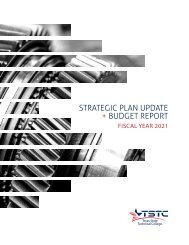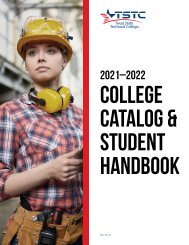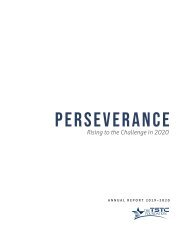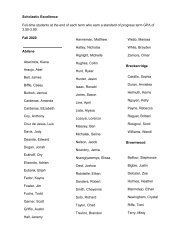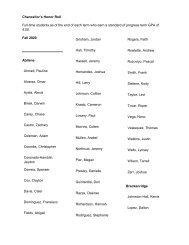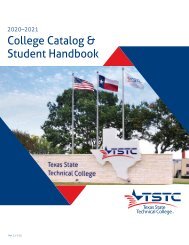Student Handbook and Catalog 2021-22 V2
You also want an ePaper? Increase the reach of your titles
YUMPU automatically turns print PDFs into web optimized ePapers that Google loves.
Essential Elements | 251<br />
more different signals (lights, sounds, pictures). It includes<br />
the speed with which the correct response is started with<br />
the h<strong>and</strong>, foot, or other body part.<br />
• Speed of Limb Movement: The ability to quickly move the<br />
arms <strong>and</strong> legs.<br />
• Wrist-Finger Speed: The ability to make fast, simple,<br />
repeated movements of the fingers, h<strong>and</strong>s, <strong>and</strong> wrists.<br />
Physical Abilities<br />
• Dynamic Flexibility: The ability to quickly <strong>and</strong> repeatedly<br />
bend, stretch, twist, or reach out with your body, arms, <strong>and</strong>/<br />
or legs.<br />
• Dynamic Strength: The ability to exert muscle force<br />
repeatedly or continuously over time. This involves<br />
muscular endurance <strong>and</strong> resistance to muscle fatigue.<br />
• Extent Flexibility: The ability to bend, stretch, twist, or reach<br />
with your body, arms, <strong>and</strong>/or legs.<br />
• Gross Body Equilibrium: The ability to keep or regain your<br />
body balance or stay upright when in an unstable position.<br />
• Stamina: The ability to exert yourself physically over long<br />
periods of time without getting winded or out of breath.<br />
• Static Strength: The ability to exert maximum muscle force<br />
to lift, push, pull, or carry objects.<br />
• Trunk Strength: The ability to use your abdominal <strong>and</strong> lower<br />
back muscles to support part of the body repeatedly or<br />
continuously over time without 'giving out' or fatiguing.<br />
• Other: The ability to work in confined spaces that require<br />
significant flexibility.<br />
Sensory Abilities<br />
• Auditory Attention: The ability to focus on a single source<br />
of sound in the presence of other distracting sounds.<br />
• Depth Perception: The ability to judge which of several<br />
objects is closer or farther away from you, or to judge the<br />
distance between you <strong>and</strong> an object.<br />
• Hearing Sensitivity: The ability to detect or tell the<br />
differences between sounds that vary in pitch <strong>and</strong><br />
loudness.<br />
• Near Vision: The ability to see details at close range (within<br />
a few feet of the observer).<br />
• Peripheral Vision: The ability to see objects or movement of<br />
objects to one's side when the eyes are looking ahead.<br />
• Sound Localization: The ability to tell the direction from<br />
which a sound originated.<br />
• Speech Clarity: The ability to speak clearly so others can<br />
underst<strong>and</strong> you.<br />
• Speech Recognition: The ability to identify <strong>and</strong> underst<strong>and</strong><br />
the speech of another person.<br />
• Visual Color Discrimination: The ability to match or<br />
detect differences between colors, including shades of<br />
color <strong>and</strong> brightness.<br />
Additional Information<br />
• Avionics Technicians often climb ladders <strong>and</strong> work on<br />
scaffolds.<br />
Biology<br />
Paul Leonard<br />
phleonard@tstc.edu<br />
Cognitive Abilities<br />
• Deductive Reasoning: The ability to apply general rules<br />
to specific problems to produce answers that make<br />
sense.<br />
• Fluency of Ideas: The ability to come up with a<br />
number of ideas about a topic (the number of ideas is<br />
important, not their quality, correctness, or creativity).<br />
• Inductive Reasoning: The ability to combine pieces<br />
of information to form general rules or conclusions<br />
(includes finding a relationship among seemingly<br />
unrelated events).<br />
• Information Ordering: The ability to arrange things<br />
or actions in a certain order or pattern according to a<br />
specific rule or set of rules (e.g., patterns of numbers,<br />
letters, words, pictures, mathematical operations).<br />
• Memorization: The ability to remember information<br />
such as words, numbers, pictures, <strong>and</strong> procedures.<br />
• Number Facility: The ability to add, subtract, multiply, or<br />
divide quickly <strong>and</strong> correctly.<br />
• Oral Comprehension: The ability to listen to <strong>and</strong><br />
underst<strong>and</strong> information <strong>and</strong> ideas presented through<br />
spoken words <strong>and</strong> sentences.<br />
• Oral Expression: The ability to communicate<br />
information <strong>and</strong> ideas in speaking so others will<br />
underst<strong>and</strong>.<br />
• Visualization: The ability to imagine how something<br />
will look after it is moved around or when its parts are<br />
moved or rearranged.<br />
• Written Comprehension: The ability to read <strong>and</strong><br />
underst<strong>and</strong> information <strong>and</strong> ideas presented in writing.<br />
• Written Expression: The ability to communicate<br />
information <strong>and</strong> ideas in writing so others will<br />
underst<strong>and</strong>.<br />
Texas State Technical College<br />
tstc.edu


